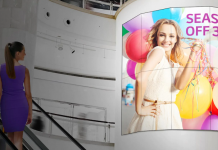Ellyce Kelly, client relationship manager at Visix, discusses how companies can appeal to the five senses with digital signage.
Using sight and sound to craft pleasing digital signage
Claude Debussy said, ‘Beauty must appeal to the senses, must provide us with immediate enjoyment, must impress us or insinuate itself into us without any effort on our part’. Our senses tell us what is real and what is not, and we rely on them for information about the world around us. They also trigger emotional responses.
We know the five physical senses – sight, hearing, touch, taste and smell. Digital signage mainly focuses on sight, which makes sense since over 80 per cent of the information we take in comes to us through our eyes. But what about the other 20 per cent? Can our other senses be leveraged in a way that creates a lasting impression and is emotionally satisfying to an audience? Here are some tips on how to create immersive experiences to engage your audience, whether you are a restaurant using a menu board or a retailer with a simple LCD:
Visual
The first thing is to create beautiful content — if it’s appealing, people will stop to look at your screens. Motion draws the eye, which is why video is so effective on digital signs. Information like weather, date and time, news feeds and local traffic also grab attention.
Yet visuals should be secondary to the actual information being conveyed. If too much visual information is presented at once, digital signage messages become clunky and can be irritating to look at or even confusing. Plus, the more text there is for your audience to read in a message, the longer that message needs to be on screen. Which means it can take a long time for a particular message to cycle back through your playlist.
Auditory
We get around 10 per cent of our information using our hearing, but think about how important it is to comprehension. A little audio to attract attention, if used correctly, can enhance digital signage impact. If your digital signs show a streaming newscast, it’s always better to have the sound on – otherwise, people are left watching a talking head without knowing what’s being discussed. If you can’t use sound to go with your newscast, be sure to show closed captioning so people can follow the story. In this case, show the stream full screen (going back to visual), so the eye doesn’t get confused.
Music can evoke emotions in people (we all know about calming ambient music being piped into hospitals and airports), as well as draw their attention and reinforce your brand. A study by Mood/Sacem shows that 76 per cent of customers in financial institutions felt time passed more quickly when music was playing in the background, and 56 per cent felt more comfortable discussing confidential information when there was ambient music playing.
Most sounds we like fall into the 300-3000 Hz range (which is also the range of the human voice), while sounds we find unpleasant are often in the high-frequency 2000-5000 Hz range.
A study at Newcastle University found that the most pleasant sounds for humans are:
applause; a baby laughing; thunder; water flowing; a crackling fire; rain; a champagne cork popping; a vibrating cell phone; certain sports sounds, like a baseball cracking on a bat, a basketball going through a hoop and a golf ball dropping into a hole; walking on snow and food cooking (especially a steak on a grill).
How to use scents and touch to improve your digital signage
Olfactory
Smell conveys around three or four percent of information. And we know from psychological studies that smell is deeply connected with memory. There are even a few scientists who postulate that smell was our first primary sense and that the brain grew larger in order to extend smell’s capabilities (until sight and hearing eclipsed it).
Scent marketing is on the rise, especially in the food industry and in public spaces like shopping centres. In terms of organisational communications, smell, like audio, needs to be used rarely and judiciously. All the caveats about sound apply doubly to smell. Simple, non-complex scents used once in a while might have a positive impact on your audience, but too much too frequently is almost certainly going to confuse them at best and annoy them at worst. Smell should never be distracting or overwhelming, and you want to give any previous scents time to disperse before introducing a new one into an environment.
There have been numerous studies conducted about scents, and some of the smells people like best are: freshly baked bread; bacon; freshly cut grass; coffee; the sea; fresh laundry; flowers; Christmas trees; vanilla; wood fires; lemon; babies’ heads; chocolate and old books.
Tactile
Touch accounts for one-two per cent of the information we receive from the world around us, but again the emotional impact is far greater than that. Touch is already incorporated into smartphones and tablets with haptic responses – slight vibration when a finger touches the screen. People who use haptics on interactive screens are more accurate with where they touch, and feel like they are accomplishing something more than if they just feel smooth glass under their fingers.
Touch elements are also useful when creating and deploying gamified digital signage campaigns. Whether your screen is used for a game, a survey, a quiz or some other gamified element, you can include haptics to give your audience instant tactile feedback on their responses.
How to use taste to spice up digital signage
Last but not least is taste. It may only give us around one percent of the information we get from the world, but it’s a powerful sense. It’s linked to smell – in fact, around 80 per cent of our sense of taste is actually smell (as an experiment, taste something with a strong flavour, like coffee, while holding your nose, and then without holding your nose). The sense of taste has evolved to let us know, among other things, which things are probably good for us and which things we should avoid.
Don’t wait
All this may seem like something from science-fiction, but the tech is already developed and being improved at a rapid pace. Communicators for all types of organisations can start using these techniques to craft rich experiences for audiences and differentiate their messaging.
These multi-sensory communications create neural connections in the brain that in turn associate the positive experience with the brand making it possible. But make sure your visuals, sounds, scents, haptics or flavours are high quality. Low-quality images, irritating sounds, and smells or tastes that are unpleasant will have the opposite effect from what you’re trying to achieve and leave a negative impression of your communications efforts.
Even if you only add in just one of the sense suggestions here, it will greatly enhance the impact of your digital signage. In a world of constant distraction and information overload, engaging more than just one sense is an effective way to cut through the noise and get your messages noticed. If you’ll pardon the pun, using the senses just makes sense.
This article was sourced from: digitalsignagetoday.com










